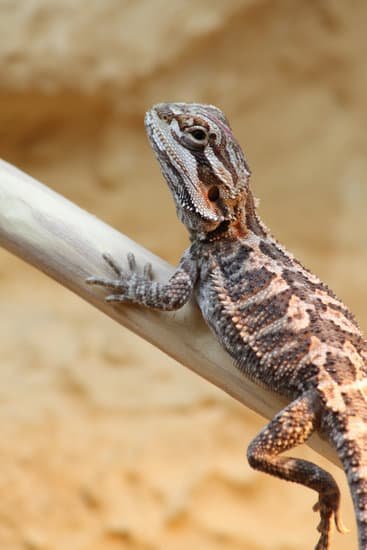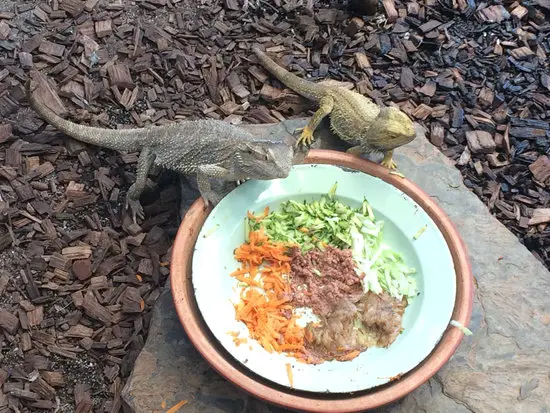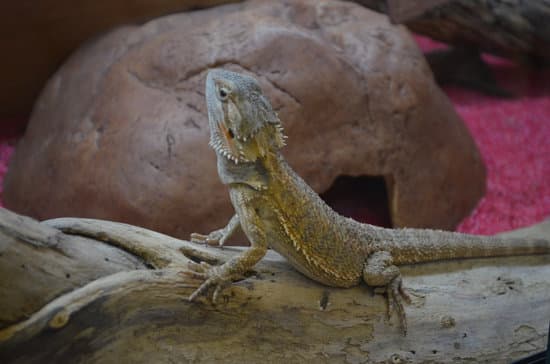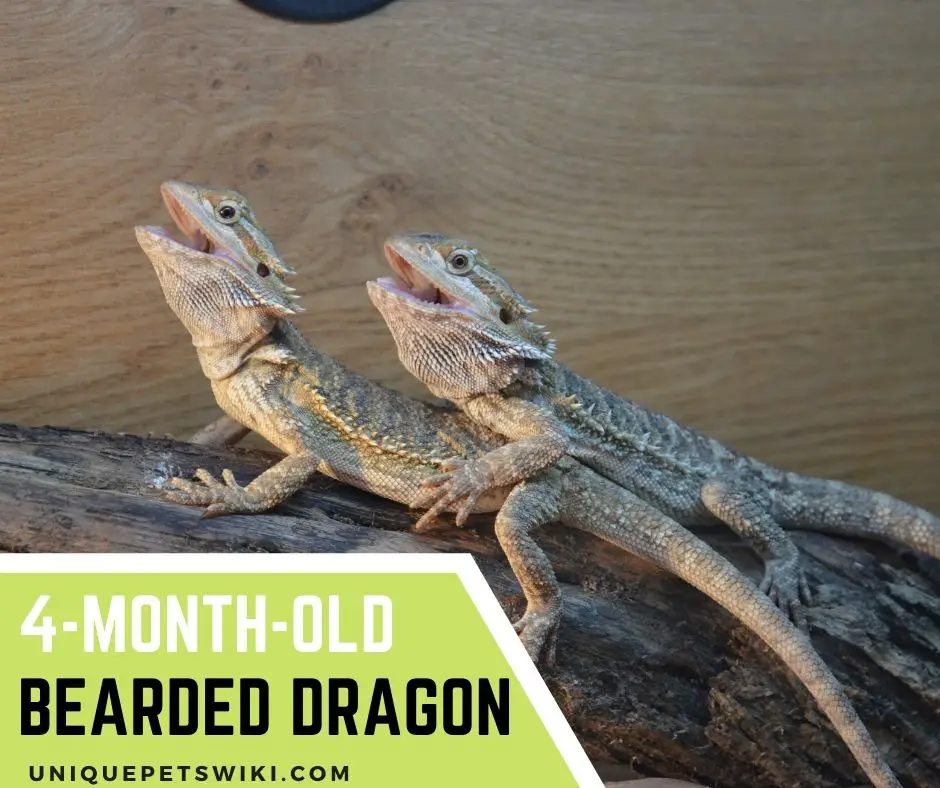You’re thinking of getting a baby beardie and want to do your homework before buying one to give them a good life. Or perhaps you have yourself one already, and are currently wondering how big they’ll get and what their basic needs are, then you’ve come to the right place!
In this article we’ll tell you how big a 4-month-old bearded dragon is, as well as other tips to take care of them, and what foods that you can give, and avoid as well as their ideal habitats, and where you can buy one!
This article has been reviewed by Dr. Dilber. Read more about our knowledge control process here.
Contents
How Big Is A 4-Month-Old Bearded Dragon?
A healthy 4-month-old bearded dragon’s size usually ranges at 9 to 12 inches, weighing at 40-115 grams. Healthy signs include high active levels, moving around the enclosure freely, and has a healthy and lively appearance, nobody parts are also swollen.
Any weight below or above this is considered underweight and overweight respectively.
Underweight is a common issue among bearded dragons this age but it is not normal. Underweight beardies have a very flat stomach, ribs and hips are protruding, their heads are considerably larger than their bodies with sunken gaps, and very thin legs and a thin tail base.
This happens because they might not be eating enough, given that they have been relocated especially at a young age, they might take time warming up to their new homes. Other reasons may also include dehydration, wrong living conditions within the tank, or other illnesses.
Providing a good diet with clean water is the main factor that needs to be focused on at a young age. If the bearded dragon is given good food but water availability is limited, the palatability of food decreases. And the baby is unable to gain standard weight. So, focus on diet and consult a vet if it has any underlying health issues.
What you can do is to rotate what you feed them, remember that variety is key to encourage them to eat. Other than diversifying what you feed them, you could also increase the amount of food, and check their tank conditions from temperature, humidity, setup, substrate, etc.
Overweight juvenile bearded dragons are another common issue, their stomachs touch the ground whenever they walk, they also have sagging beards. This results from overfeeding them their recommended diet which is 70% bugs, and 30% veggies.
Being overweight is rare in the juvenile stage of bearded dragons. However, if a beardy gains too much weight, its body systems become compromised and become susceptible to various health issues including cardiovascular and bone issues.
What you can do is feed moving insects inside the tank so that your beardies have time to enjoy the chase. You could also hold an insect with thongs high in the tank so that your beardie will climb to catch it.
And make sure you’re not overfeeding them with bugs or more than thrice a day. You could also give detoxifying supplements, but only at twice a week at best.

How Much Should A 4-Month-Old Bearded Dragon Eat?
A 4-month-old bearded dragon’s diet should consist of 30% insects, and 70% leafy vegetables, and they should be fed three times a day, on a daily basis. This is because bearded dragons at this age need protein to develop strong, and healthy.
You can feed 30-50 Dubia Roaches in a day for 4-month-old dragons, then 25-80 crickets per day instead.
Adult bearded dragons can go for two months without eating food, this is because during the cold they undergo a process called brumation, that lowers their active levels. But 4-month-old bearded dragons should eat on a daily basis, for three times a day.
If your juvenile bearded dragon is not eating regularly, go see a vet immediately, as this is an alarming case for juvenile bearded dragons that grow rapidly during this age.
Best Foods For 4-Month-Old Bearded Dragons
We all have our favorite food right? We like them because of the taste, it’s affordable, easy to make, easy to digest, our childhood snack and others. The same goes for 4-month-old bearded dragons, they in fact have their favorites, if not the best foods.
Dubia Roaches are your best bet. These insects are packed in nutrients, they’re easy to digest, and are generally safer to consume rather than crickets. They also contain high calcium and protein levels.
Crickets are also good as well! For beardies they taste great, they’re low cost, and abundant in the environment as well.
Phoenix worms are also solid options. They’re high in calcium, affordable, easy to contain, and easy to digest, and low in fat.
For veggies, the best options for Bearded dragons are Collard greens, Turnip Greens, Dandelion, and Mustard Greens, and other greens as these are really easy to digest and pack a lot nutrients that is beneficial for your beardie and follows the Calcium-Phosphorus ratio.

Foods To Avoid For 4-Month-Old Bearded Dragons
Growing up, our parents have this list of food to avoid right? Well, you can think of it this way, as your baby bearded dragons have a list too which they’re not allowed to eat.
The first on the list is avocados. These are toxic, dangerous, high in fat, uneven Calcium-Phosphorus ratio. Just avoid these okay? Dairy products should be avoided such as cheese, milk, yogurt.
Never feed your bearded dragon any insect that you caught outside. You don’t know what type of insect this is, and they may carry parasites which are detrimental to your bearded dragon’s health.
Lettuce iceberg should also be avoided along with spinach, and kale, as these foods are high in goitrogens which can cause problems in health and can stunt growth for your bearded friend.
Any citrus fruits should also be avoided at all costs. The citrus affects their stomachs and can cause digestive problems. Onions, Mushrooms, Rhubarbs should also be avoided too.
You should also avoid feeding flavored or preserved foods to the bearded dragons.
2 Tips To Take Care Of A 4-Month-Old Bearded Dragon
You’ve been properly feeding all the right foods and avoiding all the wrong ones to your bearded dragons. But there are still other factors that play a major role towards the growth and health of your bearded friend!
These are of course their tanks or habitats, and their unique personalities.
Ideal Habitat For 4-Month-Old Bearded Dragon
A juvenile bearded tank is a bit more specialized compared to an adult bearded dragon tank. This is because they’re still young which means they need more careful care, but you can gradually adjust the tank for your beardie as it grows.
Bearded dragons in captivity need a cage, no matter what the age because of their specialized needs. Such as specific substrates, humidity and temperature levels, and other factors that are crucial and important factors to their health.
Be careful too about changing cages, because a bearded dragon that’s only 4-Month-Old experiences stress quite easily compared to other ages. Changing cages can cause your beardie to not eat that much, or be prone to illnesses, or even have stunted growth.
The ideal habitat should have the following for 4-month-old bearded dragons:
- Size of the tank should be no smaller than 20 gallons but 40 gallons is optimal.
- The measurement should be 36 inches in length, 18 inches in width and another 18 inches in depth.
- General Temperature at 80°F (26°C) to 85°F (29°C).
- Basking Area Temperature at 95°F (35°C) to 110°F (43°C)
- Cool areas at 80°F (26°C) to 90°F (32°C)
- Humidity at 30%-40%
- No loose substrates. The recommended substrates are reptile carpets, newspapers, or tiles.
- Places to hide, dig, and climb.
- Water bowl that is changed every or two hours.

Tip: Always have a hygrometer, and thermometer ready.
The size of the tank should gradually increase to 75 gallons for young adults and 120 gallons for full adults.
4-Month-Old Bearded Dragon Behavior
Living alone is optimal for bearded dragons regardless of age. You don’t have to worry that your beardie doesn’t have a friend, it won’t get lonely, or affect them in any sort of way.
Though cohabiting is not necessarily forbidden or not allowed, it is recommended that bearded dragons live alone. But you can keep two females, together or a male and female pair and this won’t pose any problems.
Problems occur when you keep two males as they compete with territory, and exhibit aggressiveness towards one another. It is also advised that you don’t keep different sizes of bearded dragons together as this can pose bullying, and injury on the smaller beardie.
For estrus (sexual feeling), this naturally occurs at ages 12-18 months. So you don’t have to worry about the breeding season just yet if you have a 4-month-old bearded dragon.
Let’s talk about shedding. For babies until juvenile bearded dragons, they will definitely shed a lot more and more frequently compared to adult bearded dragons.
This is because their growth rate is faster compared to the adult ones. On average, a 4-month-old bearded dragon sheds every 1-2 weeks, and within these weeks, they shed for 1-2 days. This is because their growth rate is faster compared to the adult ones, as general knowledge goes, as your bearded dragon grows older, they shed less.
If you think your beardie is shedding, look out for these signs or changes: Skin color, diet, eye bulging, and behavior. Loose grey skin will unfold, and a loss of appetite is normal as well as your beardies continue to shed.
How Much Does a 4-Month-Old Bearded Dragon Cost?
4-month-old bearded dragons cost anywhere between $45-$100 and depend on the breed, color, location and type (there are color morphs that are the most expensive type of bearded dragons.
Female bearded dragons usually cost 10% more than male bearded dragons, the reason behind this is since they can produce offspring, and males can’t. So be careful if you’re going to purchase a female bearded dragon instead.
If you’re in the market looking for a bearded dragon, 4-month-olds could be best for you! Let’s say you did your best to research bearded dragons, and are ready to spend a good 10 years with them. Here are the reasons why:
- 4-month-olds are a good purchase too, they’re affordable, and have higher survival, as long as you can give them their specific needs.
- It is also recommended to buy a baby bearded dragon (6 weeks above) if you want a younger version of 4-month-olds that has similar living requirements.
- Baby bearded dragons have a better chance at surviving, making them easier to take care of, and can put peace of mind about losing money and disappointment.
Tip: Don’t buy a bearded dragon that’s less than 6-9 inches long.
There are a lot of places to buy a 4-month-old bearded dragon, but the best place is your local pet store. There are also local breeders you can contact, but sometimes breeders sell a more expensive bearded dragon compared to your local pet shop.
You can also purchase from reptile expos, shelters, and rescues. The downside for reptile expos is there are not many of them, and if there are, they’re usually quite far from commonplaces, but hey bud, try it too.
A good thing about reptile expos is that you can ask all of your questions to your heart’s content, and who knows, you might stumble upon another pet too! For rescues and shelters, it’s always a good idea to adopt but be careful in picking, you might end up with a sickly bearded dragon.
The downside of purchasing from your local pet store is that the clerks can’t answer most of your questions, they’re usually equipped with basic knowledge. But anything too specific might be something they can’t answer, but this is the most convenient method!
So you might want to consider looking for a reputable breeder instead that can answer all of your questions, it might be worth the price for a bearded companion!
Conclusion
4-month-old bearded dragons are definitely good companions, and fun to watch them grow! Just be careful of their needs, and remember that the condition of their tanks greatly affects their health!
We hope that you found this article useful in taking care of your bearded friend, best of luck, and enjoy the ride!
